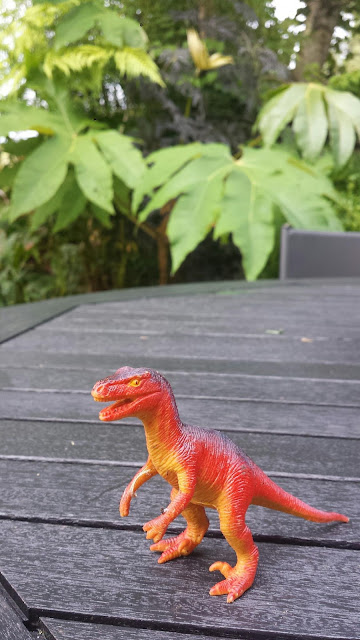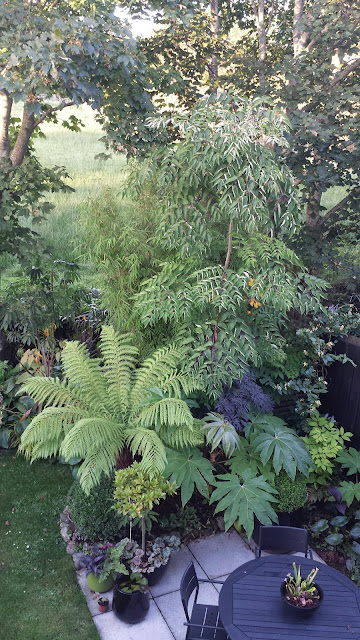Please excuse the fact that the text is centred, I've edited it numerous times but blogger refuses to play ball today.
Succulents are a major thing in my gardening life now.
A few years ago I wasn't keen on them at all, as a group of plants. I suppose I'd seen too many specimens in my time, sitting on windowsills indoors, not getting enough light and merely existing. They seemed so inanimate, of course I was aware that they grew but any change seemed unperceivable not the most exciting, or so I naively thought.
A seismic shift in my thinking occurred about four years ago. A visit to Cornwall in the extreme SW of the UK with a great gardening friend introduced me to succulent growing on a grans scale, how it should be done. The mild climate of the area allows Agaves, Aeoniums and the likes to grow fat and proud, relishing getting their roots in the ground and wallowing in the ample rainfall that the region receives.
The Minack theatre not far from lands end occupies a precipitous position, tumbling down the cliffs in a natural amphitheatre which was turned by Rowena Cade during the last century into an outdoor theatre. It receives the full force of the Atlantic ocean right in the face, there's nothing but water between this point and the east coast of the USA.
The Abbey gardens on Tresco in the isles of Scilly which were visited later in the week were a revelation and cemented in my mind the slowly forming ideas of how succulents should be grown. Not dotted about here and there with bare soil between, but growing cheek by jowl, making the most of the varying shapes, forms and colours.
Since then I've been building on my collection, adding more each year, but however unlike in Cornwall, my succulents are not outdoors year round, my conditions over winter are just too much for many of them. It's not the cold, but the wet. From autumn right through to spring we get prodigious amounts of rainfall and this combined with cold conditions would be the downfall of manys a juicy plant, growing on the edge of hardiness.
Contrasting texture is what I'm after, playing hard and loose with the rules of what should and shouldn't be grown together.
Pelargoniums (here the variety 'Mrs Pollock') come from a Mediterranean climate, so why not bed them in next to Aeoniums?
Certain plants such as various Astelias and Aloe striatula are planted permanently, while the x Mangaves and Echeveria are crammed in around them from late April through to September.
 Smaller specimens are tucked in among the stone walling, giving the illusion that they're happy year round residents, which I think is key. This little Agave 'Cream Spike' produced, (like all the Agave do when bedded out) masses of roots, really enjoying their summer holiday in the ground.
Smaller specimens are tucked in among the stone walling, giving the illusion that they're happy year round residents, which I think is key. This little Agave 'Cream Spike' produced, (like all the Agave do when bedded out) masses of roots, really enjoying their summer holiday in the ground.
Agave 'Cornelius' is a new favourite, picked up from Cotswold Garden Flowers (don't let the name put you off, it's a treasure trove of the unusual) near Evesham, Worcestershire, last May.
But then, the time comes, normally around mid/late September, where I have to think about digging up the majority of them. I try to time it so that they're dug following a dry spell, that way the go into the cold greenhouse relatively dry. Rot is then is much less likely to set in during the dark, dank days of winter. Most will not receive any water unless absolutely necessary when residing in their winter quarters. It's a tough regime offering them little love from October through to April, luckily they're resilient characters.
This was a sport I found on an Aeonium, though I don't know the parents species name, I'm incredibly fond of it and hope it'll start producing offset soon so I can prop it as I'd hate to lose it. It easily popped from the ground and was potted into a teracotta pot.
Echeverias are incredibly easy to deal with, most will lift easily out of the ground and are placed in trays with a little compost in the bottom, and will be happy here until spring.
With each passing year, and assuming that I'll have them for some time, the Agaves become trickier to deal with.
Quite apart from the spines which impale me given the slightest opportunity their increasing size means that housing them in pots and carting indoors becomes more difficult. Though the spikes in the hands are an occupational hazard that I'm more than willing to accept.
It's really just a more adventurous form of bedding plants, but not using carpets of Impatiens and Begonias, not that I'd rule either out if I thought them suitable for the look.
It's really just a more adventurous form of bedding plants, but not using carpets of Impatiens and Begonias, not that I'd rule either out if I thought them suitable for the look.







































































